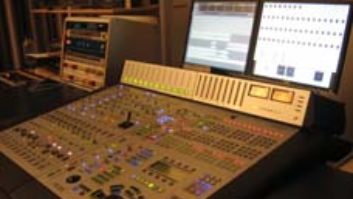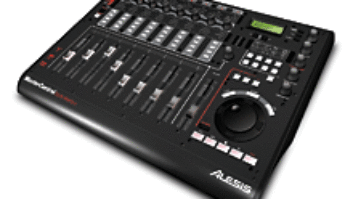In the pro audio world, a bargain is a beautiful thing — especially when your purchase offers a full feature set, ease of use and great-sounding output. Fairlight’s Dream Constellation definitely fills the bill, providing all of the things you’d expect from a console in this price range and more.
The Dream Constellation digital mixing system is capable of 192 channels of digital and/or analog audio and up to 72 output buses ready for any surround format up to 7.1. In addition to full automation of all controls, including onboard processing and parameters, routing and third-party plug-ins, the Constellation has a built-in 48-track hard disk recorder and editor.
THE SYSTEM
The Constellation comprises a control surface connected to an individual eight-space rack unit — the QDC rack — using TCP/IP Ethernet over a standard Cat-5 cable. The QDC rack contains two hard drive bays: a system drive and generally a removable SCSI drive for project files. The QDC rack contains up to six QDC processor cards: the heart (and brains) of each Fairlight Dream system. The new QDC-XT cards allow (via its more compact size) for up to eight processor cards in a same-size rack. Each QDC card has eight Analog Devices SHARC processor chips running 40-bit floating-point math and 128 MB of waveform memory.
I reviewed the Constellation console that uses four cards for 144 channels and 48 buses, with a maximum of 192 channels and 72 using six QDC-XT cards. (This month, Fairlight plans to release an upgrade that will take the system to more than 250 channels.)
A CLOSER LOOK
The Dream Constellation comes in three-bay (63.8 inches wide) and five-bay frame (102.5 inches) versions. Both frames are 28.3 inches tall at the meter bridge and have external power supplies. I reviewed the three-bay model with the Central Assign panel in the middle bay and 12 fader banks on both sides. The fader bank panels are hinged to lift up for maintenance and are USB-powered. Each motorized fader has an individual LCD to indicate its level (in dB) and current assignment (track, bus or group).
The Channel panel has controls for input/insert, EQ, dynamics, aux send and panning. You can have one of these Channel panels above each fader bank for convenience, but only one is required for full operation.
Central operations are carried out on the Binnacle Editing interface: an easy-to-learn jog wheel surrounded by dedicated, illuminated keys for transport and range, play/jog, jump, from/to, copy, cut, erase, trim/slip and fade. I found this tool fast, intuitive and easy to learn.
Typically, two flat-screen plasma displays are used with the Constellation: one for all file management, waveform editing and track views; and another showing routing and all fader activities with pop-up screens for EQ, dynamics, panning and third-party plug-ins.
48-TRACK DISK RECORDER
Fairlight made every effort to make the internal hard disk recorder behave like a digital multitrack tape deck. The same system as the Fairlight StationPlus, the Dream recording system is capable of up to 96 tracks of 48kHz/24-bit audio spooling from a single ultrawide SCSI drive. Gapless drop-in/out is possible across 48 tracks at the 48kHz sample rate. Other features include layer recording (nondestructive recording); track arm, record and rehearse at any time; and near-instant location and play to any spot in the project.
Editing features are top-notch with high-resolution scrolling waveforms of one to 48 tracks shown on the main edit screen in all transport modes. The screen’s upper section shows track-arming, metering, project management, EQ, crossfades, clip data, sound effects library and database search engine. This screen works perfectly with the Binnacle Editing interface.
CENTRAL ASSIGN PANEL
The Central Assign panel is where all bus assign, input routing, monitoring — including multiple speakers sets — and bus-to-bus mixing are accomplished. A color-coding button scheme to quickly shows which buses are already assigned and where. The system’s open architecture allows for patching any source to any destination. For monitoring, 24 macro buttons let you control up to nine speaker sets and internal and external audio sources.
For all functions, when any button on the console is pushed, the centralized light 320×80-pixel LCD shows the status of that button. All routing and a complete overview of the console’s operation are always shown on one of the flat-screen plasma displays.
The Link Group feature allows up to 7.1 channels to be under a single fader and then, with one key push, unfold out all eight channels to separate faders on the console. This is invaluable for a quick, on-the-spot rebalance of 8-channel orchestra stems during a big mix.
Lastly, the Format switch lets you instantly hear your work in any predetermined fold-down desired. You could listen to a 5.1 mix in 7.1 channels, all the way down to mono. Fold-down is a user-defined stored text file and — along with all 24 monitoring macros and up to 100 libraries of compressor/EQ/plug-in data, console, bus and routing presets — can move with the client or engineer from project to project.
CHANNEL PANEL
Above the fader bank panel is the EQ, dynamics, panning, aux send and input channel panel. This panel is used for all faders, bus outputs, master faders and sub buses. Whatever the fader or bus is set up as, from mono to 7.1 channels wide, the Channel panel follows and changes to accommodate with linked operation of all processors.
To assign the Channel panel, push the Call button located on each channel fader or from the Central Assign panel. I liked that the Call button remains lit to indicate that you are adjusting parameters for that channel. All of the motorized controls on the Channel panel are touch-sensitive, change to red when operated and trigger the appropriate pop-up menu on the plasma screen to show exactly — numerically and graphically — what the current processor and parameter value are.
INPUT SECTION AND PROCESSING
At the top of the Channel panel is a strip of controls for the channel’s input signal. Just like an analog console, there are input trim, phase, insert in/out and direct out, as well as input patching, bus routing, fader grouping and plug-in bypass. Constellation comes with 80 Creamware plug-ins of all types; a future update will allow an external PC, routed to the QDC rack via an Ethernet connection, to run VST plug-ins.
Also on the Channel panel is the compressor/gate/expander with controls for threshold, ratio, attack, release and make-up gain. The 6-band equalizer offers four parametric sections and high- and lowpass filters. Q ranges from 0.3 to 10.3, and you can select between four different filter types for each section of the parametric. Next on the panel are the aux send controls. Four controls are dedicated to aux buses 1 through 4 and two more send controls are assignable to aux buses 5 to 12. All six are stereo sends with pan pots and pre/post-switching.
PANNING AND AUTOMATION
There are complete stereo-to-7.1 panning facilities in the panning section. A single joystick is used for all formats, and the GUI is the best way to set a pan position. Controls include Spread for opening or contracting the soundfield all the way down to mono; Diverge, which controls a source between adjacent speakers; Rotate rotates the entire soundfield about the listener’s position; and Boom controls the amount of full-range audio to the sub or boom channel.
Automation is always running. There is no need to write a first pass because you can immediately add an automation move anywhere at any time. All of the usual modes are available such as snap, trim and write (or absolute), and they can be entered on-the-fly at any time. There is also a handy Preview mode in which you can rehearse an automated move without writing it.
IN THE STUDIO
My studio test started with mixing a multitrack production already on the Constellation’s hard drive. I could have also imported any files from Pro Tools or another DAW as OMF, raw .WAV or .AIFF files at any sample rate. The QDC rack will automatically sample rate — convert all incoming files to the project’s rate. With appropriate QDC I/O, I could have also imported any number of analog tape tracks, converted them to 96kHz/24-bit files and kept working. Constellation saves all audio files, automation data and EDL in one big, easy-to-find OMF file.
I set up my mix on the console so I could also derive a stereo version of my 5.1 mix. This is accomplished by “cloning” the main bus mix using the console’s Reduce mode and folding down that mix to stereo. You can make additional automation moves, EQ changes and effects — anything on this cloned mix without affecting the original main 5.1 mix. However, if the 5.1 mix is changed in any way, then the reduced mix follows. This is the best way I’ve seen to tackle stereo fold-down in surround mixing.
The first thing I noticed when I started getting sounds on the individual tracks was the powerful and great-sounding equalizer. The on-screen graphical view of the EQ and compressor/gate is essential here as there are no numerical readouts on the EQ panel, but it is easy to carve and shape with the fast-responding, touch-sensitive controls. The compressor and noise gate also surprised me with their very precise controls and more personality (if you press them) than I would have thought. My only wish for the EQ and the compressor would be to see more LED metering and numeric values displayed on the Channel panel. This would save constant head-turning to check the flat-screen monitor.
I mix records and not film, TV or commercials, so I liked how quickly I “got” this board and how “analog” it works: Everything does what it is supposed to do instantly without feeling like a sterile interface. You just call the fader channel you want to work on and the Channel panel’s motorized controls swing to where you last left them, as all of the faders, switch and rotary controllers are always remembered in static positions. I liked to stay in the sweet spot and use the centrally located Fat Channel fader that mimics the currently selected channel fader.
For 10 drum tracks, I used Link Group to put them to one fader but, when unfolded, I compressed and EQ’d the kick and snare separately and routed the overheads through a Creamware compressor. The many plug-ins’ parameters are assigned across channel faders for easy access — there is no mousing a plug-in’s GUI here!
Sending to effects is simple once you’ve set up effect send paths and returns. Returns are just connected to the assigned bus, and there is a 2-band EQ if needed.
A CONSOLE FOR ALL SEASONS
The Dream Constellation is aptly named. It was a “dream” to work on, and it didn’t feel like I had to learn a new system at all. I can’t imagine an easier yet more powerful system that is this intuitive and great-sounding. Thanks to Robert Fiest at Ravenswork Studios (Venice, Calif.) and Philippe Guichard of Fairlight’s Media Gear Inc.
Fairlight, 626/792-8773, www.fairlightau.com.
Barry Rudolph is an L.A.-based recording engineer. Visit his online at
www.barry rudolph.com.


